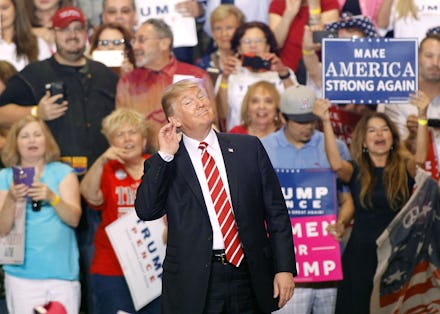Trump thinks “clean coal” is just coal that’s been cleaned off. Here’s what it actually is.

During a set of bellicose and rambling remarks at a campaign-style rally in Arizona Tuesday night, U.S. President Donald Trump briefly touched on what’s now become a familiar fixture in his stable of talking points: “clean coal.”
“We’ve ended the war on beautiful, clean coal,” Trump told the crowd in Phoenix, referencing a new mine that he claimed will soon open in Pennsylvania. “...they’re taking out coal, they’re going to clean it.”
But even alongside the litany of other contradictory ideas that Trump trotted out during his comments, the characterization of coal as something that can be dusted off and made to shine like a new penny is particularly dangerous in its wrong-headedness.
Below is a breakdown of what we’re really talking about when we talk about “clean coal.”
What is “clean coal”?
Tuesday night’s rally isn’t the first time the president has touted his support for the concept of clean coal — a phrase itself already oxymoronic by nature. During a March signing ceremony for an executive order that rolled back regulations aimed at reducing pollution from coal plants, Trump said that going forward, “we’re going to have clean coal, really clean coal.”
But “clean coal” doesn’t actually denote coal that’s somehow more environmentally friendly than some other, dirty alternative. Instead, the phrase refers to the set of technologies being developed to help power plants burn coal more cleanly, and the way that those emissions are then controlled, according to Michael Shawn Hendryx, a professor of environmental and occupational health at Indiana University.
“It’s not a term that has to do with the way it’s extracted or processed prior to cleaning,” Hendryx said in a phone interview, adding that the president’s comment on Tuesday had to be “either a total lie or a willful act of ignorance.”
Known as carbon capture and sequestration — C.C.S. for short — the “clean coal” method enables power plants to snag harmful carbon dioxide (CO2) exhaust before it enters the atmosphere.
While that might sound good in theory, there are still major hurdles to implementing the technology at the large scale that would be necessary for it to actually make a non-negligible environmental impact.
“It might be possible to do it here and there in some sites, but it’s too expensive to build the plants, and the technology for storing that much carbon dioxide permanently in some underground facilities as they propose to do is just not practical,” Hendryx said. “It’s delusional.”
Coal isn’t clean, period.
Coal, it’s worth noting, is the dirtiest source of energy available to mankind.
But it’s no surprise that the phrase “clean coal” has gained widespread popularity in recent years, percolating up through the highest echelons of power from coal lobbyists to policy makers to the lips of the president himself.
According to the New York Times, the insinuation that coal can be “clean” is just part of a larger push by the coal industry itself to vocally legitimize growing public concern surrounding man-made climate change — and to rebrand the resource as a potential player in an environmentally friendly future.
With Trump’s reference to clean coal coming in the midst of a banner year for environmental hand-wringing in the U.S. — in 2017 alone, he withdrew from the landmark Paris climate deal, appointed a noted climate change doubter to head the Environmental Protection Agency and on Aug. 20 announced the dissolution of a federal advisory committee on climate change — it’s important to remember that coal is still a dirty word, no matter how its cheerleaders try to spin it.